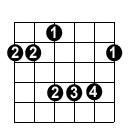An arpeggio is built from the notes that make up a chord, but are picked as individual notes. They may be used as fill-ins, linking melodies with chords and chord/melody. Arpeggios have their own patterns but not unlike their chord counterparts. There are 5 basic patterns for each type of arpeggio just like there were 5 basic patterns for each type of chord.
Picked As Individual Notes
As stated above, arpeggios may contain the same notes as their chord counterparts, but they are played a totally different way. They must be picked as individual notes. You don’t want the notes to ring together, you want them ring out separately-one note at a time. You can hear exactly what we mean in the audio examples with each arpeggio pattern.
Fingerings
The most important thing to pay attention to when learning these patterns is your fingerings. Using the wrong fingerings will hamper your attempts to play through the arpeggios. Each arpeggio pattern presented will show you the correct fingering to use. In the diagram below is an arpeggio with the fingerings labeled in the black dots.

Some of the fingerings may seem a little strange and difficult at first, but there is a reason behind each fingering. Keeping to the suggested fingerings is important because they will help you develop speed when playing the patterns.